Expert Series: Dr Chun Fong on finding the keys to unlock AML
Testing for minimal residual disease (MRD) isn’t funded for acute myeloid leukaemia in Australia and that’s “a huge hole in our ability to treat patients”, says Dr Chun Fong.
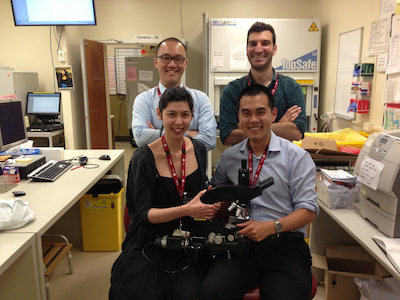
It’s a “significant limitation” and means some patients are missing out on having early progression of their disease detected, which is critical to the greatest unmet need in AML – relapsed disease.
“Molecular technologies are improving all the time and are really important in understanding the behaviour and biology behind the disease,” explained Dr Fong, a clinical haematologist and the Medical Lead for Acute Leukaemia and Myelodysplasia at the Austin Hospital (Melbourne).
“We want to make that technology more readily available to our patients, but we face the challenge of funding.”
“MRD testing is mostly done through philanthropic funding or out of hospital budgets which are always stretched.
“In hospitals that don’t have the funding capacity to be able to test for MRD, it’s done as part of a grant-funded research project, or they miss out.”
“One of the key things that we want to be able to do in Australia is to adequately fund this type of testing, so it’s more readily available for the patient.
What drew Dr Fong to research and AML?
It was a fascination with genetics and the biology that underpins the function of our genes and chromosomes – what Dr Fong terms “the instruction book for life” – that drew him to research, and in particular, translational research.
After graduating from the University of Melbourne, completing his physician and haematology training at leading Melbourne hospitals, receiving dual fellowships at the Royal Australasian College of Physicians and the Royal College of Pathologists of Australasia, his formal research training was at the University of Cambridge and Peter MacCallum Cancer Centre.
“This research was supported by the Leukaemia Foundation of Australia through a generous PhD scholarship,” said Dr Fong.
“I’ve spent some time at the bench in research, learning the skills and the language to bridge the gap between laboratory research and clinical practice.
“My PhD focused on epigenetics, where I looked at resistance mechanisms to epigenetic-targeted therapies and the leukaemia stem cell. I have a really strong interest in trying to use our knowledge of genetics to help treat patients in the clinic.”
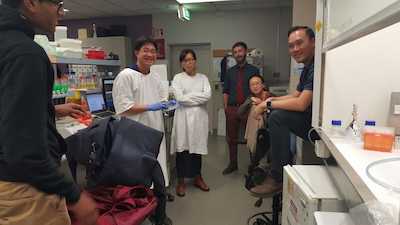
And Dr Fong’s interest in haematology stems from “how critical genetics and epigenetics is to the genesis of all cancers”.
“In acute leukaemia, for example, we base a lot of our treatment decisions on the genetic makeup of the person’s leukaemia,” he said.
In particular, for AML, Dr Fong said, “there’s been an explosion in knowledge of the disease itself, allowing us to develop treatments that target vulnerabilities which were unknown a decade ago”.
“It’s been a rapidly developing field.”
“It can be challenging and takes a bit of effort to keep up with all the literature that’s published, with new discoveries and potential new treatment options being developed all the time,” said Dr Fong.
“Conferences, discussions with my peers, email digests of journal publications from key channels – those are the things I keep an eye out for to help keep abreast of everything.”
About acute myeloid leukaemia
Dr Fong describes AML as “a very aggressive type of cancer and, fortunately, it is relatively uncommon”.
Each year, about 1000 Australians are diagnosed with AML, and who gets the disease runs the full gamut, affecting young people through to older people, with the median age at diagnosis being about 65, he said.
And this means, at times, “we run into challenges with treatment because of the slightly older age group”.
“AML doesn’t pick and choose between sex or ethnicity as to who gets the disease, and there are really no strong environmental factors.
“It ends up being, unfortunately, a bit of bad luck.”
“That’s the short story. The long story is that the body has more time to make mistakes as we get older when we’re replicating DNA,” explained Dr Fong.
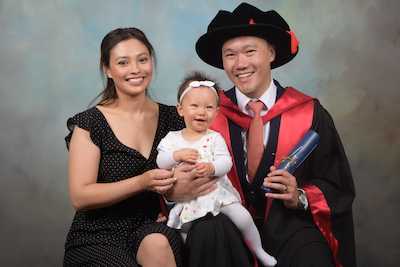
“We’ve got two metres of DNA in every single one of our cells. We have tens of trillions of cells in our body, and we make billions of cells every day, and that two metres of DNA needs to be copied exactly.
“If the body makes a mistake in copying the genetic material, then you end up, potentially, with cancer, especially if that mistake happens in the 1% of DNA that’s critical to cell function.”
A brief history of AML treatment
“Until recently, nothing had really changed in leukaemia treatment from the first series of publications in the early 1980s, so when I was in kindergarten,” said Dr Fong.
“For the last 30 years, we’ve used the same two drugs in different doses and different timings.
“What we have improved is our ability to support patients through intensive therapy. That’s been the key difference. We now know how to deal with the complications of aggressive chemotherapy.
“It’s only really been since 2017 that we’ve had this explosion of potential treatment options.”
“The main change is the development of targeted therapies directed against particular mutations or against key vulnerabilities in the leukaemia itself. These drugs have opened up a number of exciting therapeutic options for our patients.
“The analogy is… rather than using a sledgehammer to hammer in the nail and causing collateral damage, we’re using a key and a lock to unlock vulnerabilities in the leukaemia cells so we can be selectively rid of the leukaemia.
“When we talk about treatment for leukaemia, AML in particular, we split our treatment decision-making, or treatment paradigms, in two,” he said.
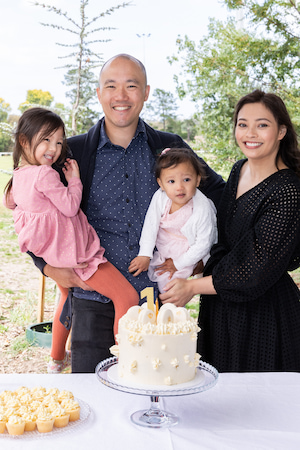
“The first part is those patients that are fit enough or eligible for intensive induction therapy; that’s really aggressive therapy to beat the leukaemia into submission, then potentially following that up with a bone marrow transplant.
“And the second treatment paradigm is for those people that aren’t eligible for intensive chemotherapy because they’re older or they have other medical problems, where we use less intensive therapies.
In the last 12 months, Dr Fong said “there have been substantial changes”, with data in key publications demonstrating that lower-intensity treatments in combination with targeted therapies is very effective for older people who haven’t tolerated heavy-duty treatment.
“There are a couple of exciting new therapies that have just exited clinical trials and that hopefully will be more readily available in the coming years.”
New AML treatment options
“In the younger patient population who are fit for intensive therapy, we’ve got new targeted therapies that are now standard of care; molecular-targeted therapies directed against an abnormal protein named FLT3,” said Dr Fong.
“Midostaurin (Rydapt®) is the first treatment in the last 30 years that has been proven to be effective in changing outcomes.”
“And there are now second-generation inhibitors, such as gilteritinib (Xospata®), that have just gone through Phase III clinical trials in the U.S. and look very promising to get people into remission and onto bone marrow transplants.
“Gilteritinib is not available on the Pharmaceutical Benefits Scheme yet but is Therapeutic Goods Administration (TGA) approved.
“In addition, there are new therapies directed against other abnormal proteins IDH1 or IDH2 which have been very promising.
“These drugs have really changed our treatment options.”
“Patients who would otherwise have had relapsed or refractory disease that was incurable, we can now potentially get into remission and get them to a bone marrow transplant and cure,” said Dr Fong.
“A new suite of studies being run through the Australasian Leukaemia & Lymphoma Group (ALLG) will now explore these drugs in the upfront treatment setting.
“The ALLG is taking part in a global initiative [the HO150/AMLM23 trial], designed and run through a group called HOVON in the Netherlands to prove the effectiveness of targeted therapies [ivosidenib (Tibsovo®) or enasidenib (Idhifa®)] which I think are very promising.

“Other studies in earlier phase clinical trials for patients with relapsed or refractory disease are based on our experience with immunotherapies in other malignancies. These studies, looking at bispecific antibodies and even CAR T-cells, are very early on in their development in AML but hold substantial promise if we can get it right.
“These immunotherapies will be directed against AML antigens, and the challenge is finding the right antigens because many AML antigens are shared with normal stem cells.
“Cellular therapies in general in AML have been hotly investigated overseas. Some are available in Australia now, but more will be coming on the horizon.”
In the older patient population, Dr Fong said, “before, we didn’t have much to offer them”.
“New data from Phase III clinical trials, for venetoclax (Venclexta®) used in combination with azacitidine or low-dose cytarabine, in particular, led by an Australian professor Andrew Wei (the VIALE-C study) has really changed our ability to administer treatment for patients who are a little bit older and may be a bit frailer,” said Dr Fong.
“We’ve been able to buy them more time, without a terrible amount of toxicity as a trade-off, and so I expect that this is going to dramatically change outcomes for our patients in the longer run.
“We don’t have ready access to those drugs just yet. They’re going through the TGA and Pharmaceutical Benefits Advisory Committee processes, but I’d hope that in the near future we’d be able to use those treatments for more patients,” said Dr Fong.
Acute myeloid leukaemia’s greatest unmet need – relapsed disease
“If we can get people into remission and keep them in remission, then they do well,” said Dr Fong.
“The concept of maintenance therapy is not new, but we’ve not had effective, non-toxic tools to achieve this up until recently,” said Dr Fong.
“Recent publications have suggested that this is a very effective strategy. We’re extending this approach in active clinical trials to prove it works more broadly and with other drugs.
“That’s the aim of ALLG’s AMLM22 study (The International AML Platform Consortium Trial); to use maintenance therapy to eradicate any microscopic leftover disease, keep the leukaemia away for longer, and potentially for good.
“Our worry is when the disease comes back it becomes much harder to get people into remission. It is just that much harder for us to deliver effective therapy because the disease has evolved, and toxic therapies are less tolerable.
“Your survival, if leukaemia comes back, is dismal, so the greatest unmet need at the moment in AML are patients with relapsed disease.”
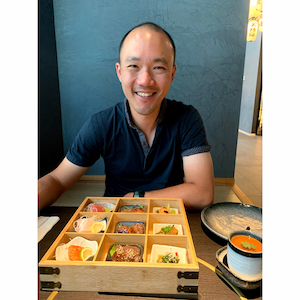
The INTERCEPT study
Dr Fong said another ALLG study that is in the process of getting off the ground addresses another interesting therapeutic concept.
“Traditionally, what we’ve done in leukaemia is treat when we get morphological relapse (a subjective assessment when looking down a microscope of 5% blasts) – that’s relapsed disease.
“The INTERCEPT study is looking at intervening earlier, using newer, more sensitive technologies to detect lower levels of disease, down to 0.01% leukaemia cells or even less,” said Dr Fong.
“We know that very low levels of disease, which is called minimal residual disease (MRD), can and does predict for relapsed or impending relapse of disease.”
The INTERCEPT study is intervening at those lower levels of disease using targeted therapies.
“These are less toxic therapies which, like a surgeon with a scalpel, cuts out the leukaemia before it starts causing problems.”
While Dr Fong said this trial won’t open at the Austin, “because of the challenges with funding collaborative group studies”, it is a trial he would highly recommend for early relapsed disease.
“Our plan is to cross-refer to other sites. We work very closely with each other, particularly in Victoria, to get the right treatment for the right patient at the right time.
“We would love to be able to give all of our patients all their treatment close to home, but it just sometimes means that they have to travel a bit further,” said Dr Fong.
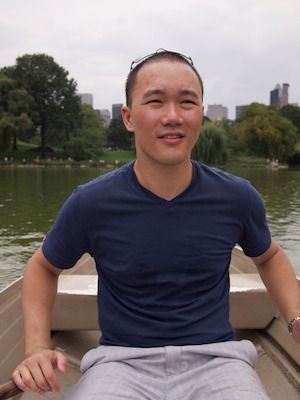
Access to AML clinical trails
“The default recommendation at the Austin and for all of my patients is entry onto a clinical trial. If there is a clinical trial for you, then we focus on getting you access,” said Dr Fong.
“It’s only really recently that we’ve had access to newer therapies, and those newer AML therapies, which have been very effective, were only available in clinical trials.
“Clinical trials enable patients to have access to state-of-the-art treatment that may not be otherwise available and mean that we can continue to contribute to the knowledge of how to best tackle a very aggressive cancer,” he said.
“Some patients say, ‘I don’t want to be a lab rat’, but I reassure them that, ‘you’re not being a lab rat, I’m just using this as a mechanism to get you the latest and the greatest drugs’.
“Most people are for it. Most people are very agreeable to try drugs on a clinical trial.
“I think clinical trials are an essential component of any patient’s management.”
“Clinical trials are the best way we have of developing new therapies and improving the outcomes of patients.
“If we go back to the treatment of acute lymphoblastic leukaemia (ALL) the 1950s and 60s, it was deemed an incurable disease in children. It’s only been through clinical trials, which have been the default for decades in the treatment of childhood cancer, that we have developed new treatment strategies and tried new drugs which allow us to cure 95+% of children with ALL. We haven’t achieved that in adults with ALL just yet, but it’s a framework for us to work with,” said Dr Fong.
“Clinical trials improve outcomes, and it’s only if we get everybody onto a clinical trial that we can truly make a difference in patients in the long run.
“Hopefully none of my loved ones gets leukaemia, but I would strongly recommend a clinical trial to them.”
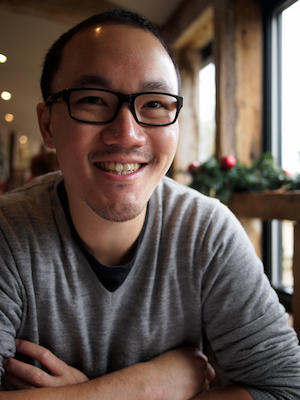
What newly diagnosed AML patients are told
The first thing Dr Fong tells his new patients is that, unfortunately, they’ve got a very aggressive cancer that needs treatment, and needs treatment relatively quickly.
“I tell them the bone marrow factory that normally produces their blood cells has been taken over by a very bad player, and we need to use all the tools we have to clear out the factory and get their normal blood-forming cells working again,” said Dr Fong.
“I’m pretty upfront with my patients.”
“I tell them the prognosis is generally not good unless we can get them into remission, and to get them into remission, there can be substantial toxicities of treatment, and the treatment options available to them are largely dependent upon how old they are and what their other comorbidities are.
“In a younger patient, I tell them I’m going to bring out all the big guns and try and blast away the leukaemia to get them into remission, and if they have high-risk genetic features, we’ll get them to a transplant if available.
“In the older patient population, I tell them we’re going to try and do everything we can do, without causing them too much toxicity, to get them into remission and buy them some time.
“I talk in general terms about the newer therapies which might be very effective in buying more time but in general the picture is one of a challenge, but with cautious optimism.”
Keeping patients fully educated
Many of the concepts Dr Fong talks to his patients about “are foreign to most people”.
“When we talk about genetics, most people, unless they had an interest in biology before or are in the business, tend not to have this as front of mind.
“It is introducing new concepts to them. It takes time to understand, and it takes an ongoing education process to get patients to fully understand what’s going on in their body.
“I think it’s really important that they are informed, so they can be an effective partner in working out what to do with their leukaemia,” said Dr Fong.
“Some patients don’t want to know, and that’s fine too.”
“But I generally find that patients with a reasonable understanding of what’s going on, tend to work hand-in-hand with a team to treat their leukaemia.
“It may not mean that the drugs work better, but it certainly improves their quality of life and reduces stress.”
The importance of genomic testing for everyone with acute leukaemia
Dr Fong said most patients are initially “sideswiped by the information that they have leukaemia” and they don’t necessarily absorb and process all the information and recommendations.
He highly recommends genomic testing for all his newly diagnosed patients, irrespective of age.
“The reason being, it tells us a lot about the leukaemia, its potential behaviour, and response to therapies, and allows us to identify genetic abnormalities that we might be able to target with specific drugs,” he explained.
The problem, however, with genomic testing is… it takes time.
“So cytogenetics – the old-school genetic testing – gives us low-resolution detail and is the quickest to come back. It can take between 24 and 72 hours to get information on select genetic mutations. This doesn’t tell us the full picture but does allow us to make immediate, time-sensitive decisions.
“The more in-depth genomic sequencing for various mutations – the high-resolution details that we need – can take anywhere from four to six weeks.
“I tell patients, ‘we’ve got to send all the samples (bone marrow) off right at the start’.
“Most of them don’t cotton on to the fact that the genes we test for are very important in detailing prognosis, but we generally do everything that needs to be done and it’s a default for us to send genomic testing off,” explained Dr Fong.
“There’s a strong recommendation for everyone to be sequenced.”
The other problem is… genomic testing isn’t funded in Australia.
“So there’s a bit of variation in practice between different institutions as to who gets genomic sequencing upfront but it’s now considered standard of care,” said Dr Fong.
Bone marrow transplantation in AML
Only a select group of patients with AML are fit enough to go through a bone marrow transplant (BMT), also known as a stem cell transplant.
“With 65 being the median age of diagnosis, more than half of our patients won’t be eligible for a BMT because of their age or other medical issues,” said Dr Fong.
“And then BMT has to be done in the correct context, meaning the benefits have to outweigh the potential risk of the leukaemia, and the way we work that out is with genetics.
“Then you whittle it down even further, because not everybody will have a donor for the bone marrow transplant. So a minority of patients actually end up proceeding to a bone marrow transplant.
“It is very important in some patients to get them to a transplant, particularly those with relapsed or refractory disease, or those with very high-risk leukaemias, because it’s the only chance they have of a durable remission or a cure.
“But it’s not a walk in the park and there’s a lot of education that needs to be undertaken, and assessment to be undertaken, to ensure that the correct treatment approach is undertaken for them.”
What providing high quality patient care means
Providing high quality patient care, which Dr Fong also describes as “holistic patient care”, is a team sport and it doesn’t just involve haematologists. We also rely on a dedicated core of nurses and nurse coordinators, junior doctors and supports in the community like the Leukaemia Foundation, he said.
“It also means that we consider everything in the patient, not just their disease, not just their physical capacity to undertake treatment, but also things like their social situation.
“It’s making sure that the support that they need is there to get through a life-changing diagnosis and treatment that is tough and debilitating. So that means having a social worker involved, psychological support, and people like physiotherapists, and occupational therapists, if required, to help set them up at home.”
What Dr Fong would do if he was diagnosed with AML
“The first thing that I would do is give my kids a hug, because I know that I’m in for the long haul,” said the father of two.
“It’s going to take a lot to get things into remission. And I’ve seen plenty of patients struggle through treatment – patients who you would have otherwise thought would sail through it.”
And what’s the first thing he suggests his patients do when diagnosed?
“Take a deep breath and take it one day at a time. They will be overwhelmed by information, and it will take time to process that. It will take time for the treatment to work. And you need to trust your treating doctors,” he said.
“Don’t go to Dr Google. There is a lot of support out there from excellent places like the Leukaemia Foundation. There’s lots of good information that can be found, and it’s not all doom and gloom.”
Dr Fong’s holy grail
“As a haematologist, the ultimate thing would be to be able to tell people with leukaemia that this is something we can cure… in everybody. That would be my holy grail.
“We just have to find the right set of keys.”
Find out about the Leukaemia Foundation’s investment in innovative AML research.
Last updated on April 13th, 2023
Developed by the Leukaemia Foundation in consultation with people living with a blood cancer, Leukaemia Foundation support staff, haematology nursing staff and/or Australian clinical haematologists. This content is provided for information purposes only and we urge you to always seek advice from a registered health care professional for diagnosis, treatment and answers to your medical questions, including the suitability of a particular therapy, service, product or treatment in your circumstances. The Leukaemia Foundation shall not bear any liability for any person relying on the materials contained on this website.